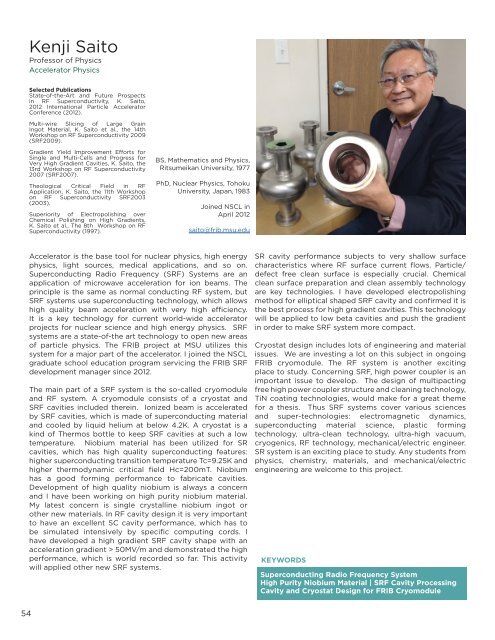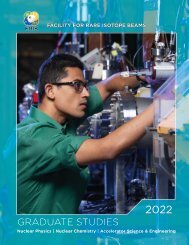2021FRIB/NSCL Graduate Brochure
You also want an ePaper? Increase the reach of your titles
YUMPU automatically turns print PDFs into web optimized ePapers that Google loves.
Kenji Saito<br />
Professor of Physics<br />
Accelerator Physics<br />
Selected Publications<br />
State-of-the-Art and Future Prospects<br />
in RF Superconductivity, K. Saito,<br />
2012 International Particle Accelerator<br />
Conference (2012).<br />
Multi-wire Slicing of Large Grain<br />
Ingot Material, K. Saito et al., the 14th<br />
Workshop on RF Superconductivity 2009<br />
(SRF2009).<br />
Gradient Yield Improvement Efforts for<br />
Single and Multi-Cells and Progress for<br />
Very High Gradient Cavities, K. Saito, the<br />
13rd Workshop on RF Superconductivity<br />
2007 (SRF2007).<br />
Theological Critical Field in RF<br />
Application, K. Saito, the 11th Workshop<br />
on RF Superconductivity SRF2003<br />
(2003).<br />
Superiority of Electropolishing over<br />
Chemical Polishing on High Gradients,<br />
K. Saito et al., The 8th Workshop on RF<br />
Superconductivity (1997).<br />
BS, Mathematics and Physics,<br />
Ritsumeikan University, 1977<br />
PhD, Nuclear Physics, Tohoku<br />
University, Japan, 1983<br />
Joined <strong>NSCL</strong> in<br />
April 2012<br />
saito@frib.msu.edu<br />
Accelerator is the base tool for nuclear physics, high energy<br />
physics, light sources, medical applications, and so on.<br />
Superconducting Radio Frequency (SRF) Systems are an<br />
application of microwave acceleration for ion beams. The<br />
principle is the same as normal conducting RF system, but<br />
SRF systems use superconducting technology, which allows<br />
high quality beam acceleration with very high efficiency.<br />
It is a key technology for current world-wide accelerator<br />
projects for nuclear science and high energy physics. SRF<br />
systems are a state-of-the art technology to open new areas<br />
of particle physics. The FRIB project at MSU utilizes this<br />
system for a major part of the accelerator. I joined the <strong>NSCL</strong><br />
graduate school education program servicing the FRIB SRF<br />
development manager since 2012.<br />
The main part of a SRF system is the so-called cryomodule<br />
and RF system. A cryomodule consists of a cryostat and<br />
SRF cavities included therein. Ionized beam is accelerated<br />
by SRF cavities, which is made of superconducting material<br />
and cooled by liquid helium at below 4.2K. A cryostat is a<br />
kind of Thermos bottle to keep SRF cavities at such a low<br />
temperature. Niobium material has been utilized for SR<br />
cavities, which has high quality superconducting features:<br />
higher superconducting transition temperature Tc=9.25K and<br />
higher thermodynamic critical field Hc=200mT. Niobium<br />
has a good forming performance to fabricate cavities.<br />
Development of high quality niobium is always a concern<br />
and I have been working on high purity niobium material.<br />
My latest concern is single crystalline niobium ingot or<br />
other new materials. In RF cavity design it is very important<br />
to have an excellent SC cavity performance, which has to<br />
be simulated intensively by specific computing cords. I<br />
have developed a high gradient SRF cavity shape with an<br />
acceleration gradient > 50MV/m and demonstrated the high<br />
performance, which is world recorded so far. This activity<br />
will applied other new SRF systems.<br />
SR cavity performance subjects to very shallow surface<br />
characteristics where RF surface current flows. Particle/<br />
defect free clean surface is especially crucial. Chemical<br />
clean surface preparation and clean assembly technology<br />
are key technologies. I have developed electropolishing<br />
method for elliptical shaped SRF cavity and confirmed it is<br />
the best process for high gradient cavities. This technology<br />
will be applied to low beta cavities and push the gradient<br />
in order to make SRF system more compact.<br />
Cryostat design includes lots of engineering and material<br />
issues. We are investing a lot on this subject in ongoing<br />
FRIB cryomodule. The RF system is another exciting<br />
place to study. Concerning SRF, high power coupler is an<br />
important issue to develop. The design of multipacting<br />
free high power coupler structure and cleaning technology,<br />
TiN coating technologies, would make for a great theme<br />
for a thesis. Thus SRF systems cover various sciences<br />
and super-technologies: electromagnetic dynamics,<br />
superconducting material science, plastic forming<br />
technology, ultra-clean technology, ultra-high vacuum,<br />
cryogenics, RF technology, mechanical/electric engineer.<br />
SR system is an exciting place to study. Any students from<br />
physics, chemistry, materials, and mechanical/electric<br />
engineering are welcome to this project.<br />
KEYWORDS<br />
Superconducting Radio Frequency System<br />
High Purity Niobium Material | SRF Cavity Processing<br />
Cavity and Cryostat Design for FRIB Cryomodule<br />
54






